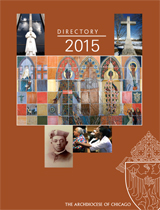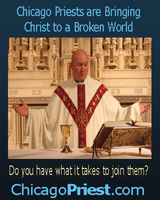December 7, 2008
A city still mourns 50 years ago, a fire killed 92 children and three nuns at Our Lady of the Angels School
Ninety-five people — 92 students and three teaching nuns — died in the fire that rampaged the second floor of the north wing of the Our Lady of the Angels School on Dec. 1, 1958. The tragedy, painstakingly documented in the book “To Sleep with the Angels” by David Cowan and John Kuenster and the subject of many magazine articles, books and films, led to reforms in the fire code for schools across the country and dramatic changes in school construction and fire-alarm systems in Chicago.
But more than bricks and mortar were affected: The people of the parish, especially the hundreds of students who were in the school, its surrounding neighborhood and the whole city still bear the marks of the fire.
Luciana Mordini was in seventh grade on the afternoon of Dec. 1, 1958, sitting near the back of Room 208 at Our Lady of the Angels School on Avers Street.
She came to the United States with her parents about four years earlier, coming from a small town in Italy with a one-room schoolhouse. Her Chicago neighborhood, with its parochial school of 1,600 children, was a lot to get used to.
But things were looking up in seventh grade. She liked her teacher, Sister Mary St. Canice Lyng, and hung around with other kids. Life was starting to feel normal.
Then, on that cold afternoon, everything changed.
The room started to get warm. The teacher told some of the boys to open the door to check the hallway, but they couldn’t open it. “It didn’t take 20 seconds for the smoke to fill the room,” said Mordini, who asked that her married name not be used.
She and the other students knew already that there could be no escape through the hallway, and Sister Canice told the students to stay calm, at their desks and pray.
“I thought, ‘I’m not doing that,’ and I went to the window,” said Mordini, who isn’t sure how many students followed her example because the smoke was too thick for her to see.
She sat on the windowsill and dangled her legs outside. She did not see any firefighters. To this day, she doesn’t think she jumped. “I’m just not the kind of person who would do that,” she said. “I truly believe someone pushed me.”
If someone did, he or she probably saved her life. She broke her fall on the roof of a shed under her classroom window before tumbling to the ground. She did not suffer serious injuries from the fall, but third-degree burns on her right arm kept her in the hospital until Christmas Eve that year.
“Some man came and got me and drove me to the hospital,” she said.
No one shielded her from the enormity of the tragedy; once she was up and around in the hospital, she was asked to help deliver newspapers to the other patients. Even so, she said, she did not comprehend the magnitude of the disaster.
“I don’t think I understood it for a long, long time,” she said. “People didn’t talk about it. It was like, if you don’t think about it, don’t read about it, don’t talk about it, then it didn’t happen. Or it didn’t happen as bad as it did.”
Mordini returned to classes in March 1959 at Our Lady Help of Christians School, which had taken in Our Lady of the Angels students while their new school was under construction. The new school opened the year after she graduated.
“I don’t blame the church. I don’t blame the school. I blame the person who did this. In my mind, I can’t see why it would be anyone else’s fault. You can’t blame someone unless they struck the match. I don’t even blame the nuns because they said, ‘Stay here,’ because that was how they were taught. I don’t think anything could have been done in those particular rooms unless the fire department got there sooner, or unless the ladders were longer.”
Room numbers
Room 208, which had 13 injured and 10 dead, including Sister Canice, (whose body was found draped over a pile of dead pupils, evidence of her futile attempt to shield the children from the flames,” according to “To Sleep With the Angels”) did not suffer the same level of casualties as some other classrooms on the second floor of the north wing of the school. Room 210, next door, had 30 dead and 15 injured; Room 212 had 28 dead and 21 injured. In Room 211, across the hall, 25 were killed and 17 injured. Two classrooms on that floor — rooms 209 and 207 — suffered lighter casualties, with two killed and eight injured in Room 209, and none killed and one injured in Room 207, which had access to the only fire escape.
But no students on the school’s first floor or in the south wing were hurt. Many thought the fire alarm, when it finally went off, signaled a fire drill instead of an actual emergency.
Mordini never had skin grafts or plastic surgery, because she didn’t want the pain. As an adult, she spent years in counseling, and feels some sense of recovery, but her faith is gone, she said.
“I’m a definite fallen-away Catholic,” Mordini said. “I’ve tried and tried, but I’ve lost my faith. I’d rather be a Catholic than anything else. It’s sad, because I came from a Catholic family. My parents understood. They didn’t push me to go to church.”
She did go to the dedication of the memorial at Our Lady of the Angels Mission, but didn’t like it much, she said. The statue of the angel reminds her too much of the memorial at Queen of Heaven Cemetery.
“It was nice that they did something there, but it was sad that the church isn’t Catholic anymore,” Mordini said. “It sounds very bad to say, but it doesn’t mean that much to me. It’s very nice, but it’s long overdue.”
Like many of the children who survived the fire, Mordini did not talk about it much for years, not until she got involved with a group called the Friends of OLA (Our Lady of the Angels), for people who survived the fire and the loved ones of those who died.
John Kuenster, who was working as a sportswriter at the Chicago Daily News at the time of the fire, did not write about it then, but came back to it and started working on a book about it years later. Eventually, he worked with David Cowan on “To Sleep With the Angels,” first published in 1996. This year, Kuenster wrote “Remembrances of the Angels: 50th Anniversary Reminiscences of the Fire No One Can Forget.”
In the 12 years between the books, Kuenster said, more people became willing to talk about the fire. But 50 years later, many have slightly conflicting memories, he said.
Mordini said there are some people involved with Friends of OLA who still don’t want to talk about what happened.
“There are still some people that absolutely refuse to talk about it,” she said. “I don’t think it’s resentment. I think they’ve buried it so deep they don’t want it to come out. We all got affected. It wasn’t just me — even the kids who weren’t in school.”
An ‘ordinary’ day
Frank Vainisi was in school that day, but he was in the only fifthgrade classroom that was on the first floor. He lived two blocks from school, in the kind of city neighborhood where he could open his window and lean out and knock on his buddy’s bedroom window next door.
On the day of the fire, “there wasn’t anything out of the ordinary of any kind,” he said.
His class was not aware there was anything wrong until the fire alarm went off. They exited the building as they had been taught, and then, because it was cold, they were sent to wait for further instructions in the church. Eventually, they were just told to go home.
Vainisi’s route did not take him past the school, so he went home without knowing much about what was going on.
“At this time, we were lucky enough not to know the severity of what was going on. When I got home, my father was just pulling up, and he had heard about the fire. He asked where my brother was, but I didn’t know.”
His father told him to go inside and wait, but Vainisi followed his father back to the school, where they found his second-grade brother sitting on the curb, watching the horror unfold before him. His father wrapped his coat around his brother and they went home.
“What I remember is the phone ringing off the hook,” he said, as parents and parishioners shared the news of who had lived, who had died and who was in the hospital. An altar boy at the time, Vainisi served some of the funeral Masses, but said there was little discussion of what happened.
“It was such a blur. My parents didn’t really talk about it,” he said.
It wasn’t until the students started being bused to classes in other schools after the holidays that what happened began to seem real.
“Then you started thinking about the friends who perished and weren’t there,” he said. He and his friends also got tired of being seen as “the fire victims.”
Once, in eighth grade, OLA played a basketball game against Maryville Academy in Des Plaines, a home for orphans and other children whose parents could not care for them.
“It was the orphans versus the fire victims,” he recalled.
Bonds forged
One of the unexpected effects of the fire is its role in cementing relationships among students who were there. “To this day, seven of us guys are very close,” said Vainisi, adding that they are closer than he is with his fraternity brothers.
Among them is John Raymond, who was in a fifth-grade class on the second floor. His father, James Raymond, was the custodian at the parish and helped rescue many students. After the fire, he was scapegoated by speculation that the school had not been kept clean and free of litter — speculation that was later debunked.
Vainisi serves on the board of James Raymond Scholarship Fund, which offers scholarships to the children of firefighters. It was created by the Friends of OLA to draw attention to the heroic acts of James Raymond.
 Catholic
New World - Newspaper for the Archdiocese of Chicago
Catholic
New World - Newspaper for the Archdiocese of Chicago Archdiocese of Chicago Directory
Archdiocese of Chicago Directory Oficjalne wydawnictwo Archidiecezji Chicago w języku polskim
Oficjalne wydawnictwo Archidiecezji Chicago w języku polskim